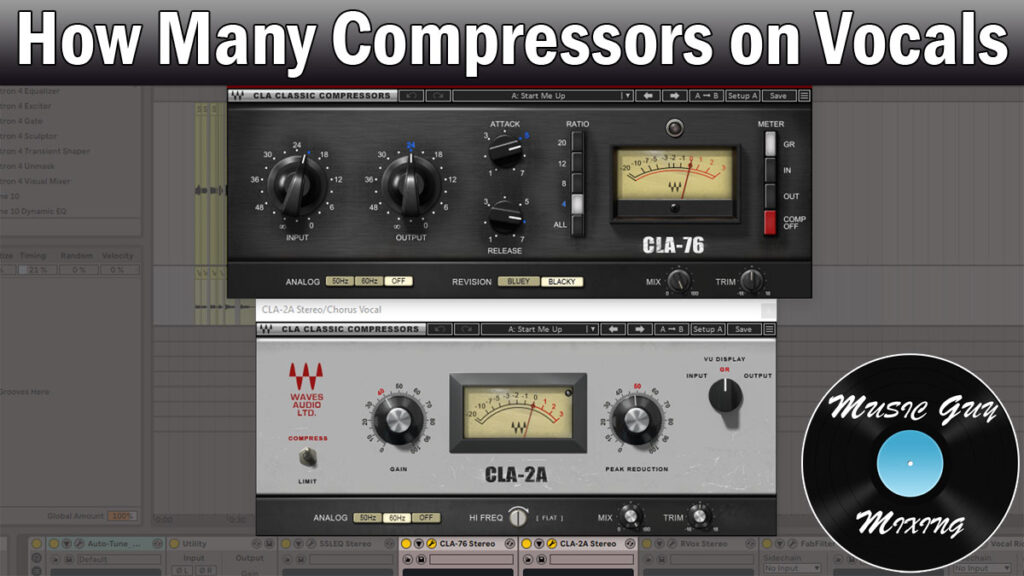You’ve probably heard some of the talking mixing heads recommend using more than one compressor on your vocals. The idea is that when you use more than one compressor, the work is more evenly distributed (it’s the principle of serial compression). Rather than one compressor doing all of the heavy lifting, there’s a more subtle and natural result.
How Many Compressors on Vocals
To answer the baseline question of how many compressors on vocals, I almost always use at least two compressors as I find I get better results with more than one.
The main thing we’re always trying to achieve with vocal compression is a smoother, more consistent sounding performance. Using more than one compressor will help achieve this, as long as you know why you’re using more than one.
Additionally, I like to use two different types of audio compressors, each with their own specific purpose.

Typically, the first compressor I like to bring in is a FET compressor which is ideal for taming peaks. FET stands for “Field Effect Transistor”, but don’t let the fancy complicated name confuse you. The point is it sounds great on vocals.
My go-to FET compressor is the Waves CLA-76, but if you check out my breakdown of the different types of audio compressors, I offer great free options you can download for each type including the FET.

After some very light EQ adjustments, I start off with the Waves CLA-76 9 times out of 10 on my vocals.
The one exception is when a vocal is extremely dynamic and just kind of all over the place. In this case I’ll just grab a stock compressor and crank up the ratio to 10 or 25 to 1 to wrangle the average level back down to earth.
Getting back to the FET, the ratio on an 1176 modeled FET compressor like this has built in positions of 4, 8, 12, or 20. Typically the 4:1 ratio (see compressor ratio explained for a complete guide to what the ratio does) is enough to create a bit more cohesion than we started with, setting the input to achieve about 5 dB of gain reduction with a relatively quick (both near the higher end on a FET) attack and release.
Remember that we don’t need to fix the audio with just one compressor, that’s why we’re pulling in a second.
Immediately after the FET, I’ll drop in optical 2A style compressor in the signal chain. These compressors are ideal for vocals as they are as transparent as it gets, meaning they don’t leave any artifacts on or color the audio.
2As like the Waves CLA-2A are ridiculously easy to set; you just set your threshold and any makeup you want on the output and you’re good to go.

You typically don’t want to drive a opto-compressor hard; it’s just for creating a little glue after the FET does its job to even things out a bit more and attain a more even signal. Here I’m looking to get 1dB on average of gain reduction, or maybe 2dB at the most on peaks.
At this point you have to listen to your track at the loudest sections to determine if two compressors were enough to get the job done.
If I add any additional compression at this point, it’s very light, similar to the 1-2dB of gain reduction I was getting out of the optical. Sometimes I’ll add something for the color it adds to the vocal.
Can You Use Too Many Compressors?
One key takeaway when discussing how many compressors on vocals is to remember there’s no such thing as using TOO MANY compressors themselves.
The only thing to be careful of is using TOO MUCH compression, meaning the threshold is too low and the ratio is too high on any one compressor.
The result of this would be too much gain reduction and a squashed sounding vocal with no dynamics, meaning no changes in volume throughout the entire track.
Note that in some genres you want less dynamics for more of that “in your face” and energetic feel to the vocals.
In denser pop music where there’s a lot going on in terms of the instrumental, you might want a more compressed vocal to keep it in the front of the mix, even after you automate the fader itself.
But the TLDR of how many compressors on vocals is:
- Using more than one compressor means each one doesn’t have to work as hard.
- This results in a less processed, more natural sounding vocal.
- Try starting with a FET compressor to tame the peaks, and getting 5 or so dB of gain reduction.
- Follow this up immediately with an opto style compressor to smooth out the remaining signal a bit more, aiming for 1-2dB of gain reduction.
- Add another compressor in the signal chain at this point if the signal is still too dynamic for your liking. You can alternatively put one closer to the end if you want to add more processing.
- Some genres and vocals will be better served with more compression, so trust your ears.

Pingback: The Best Compressor Settings for Vocals (Exact Settings to Use) - Music Guy Mixing